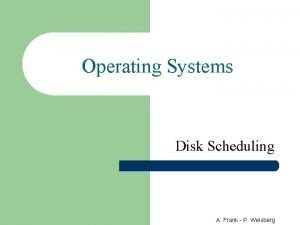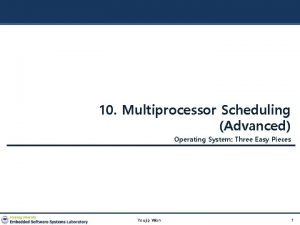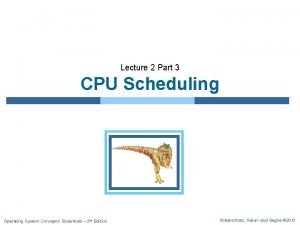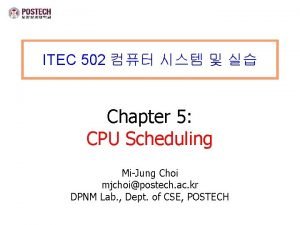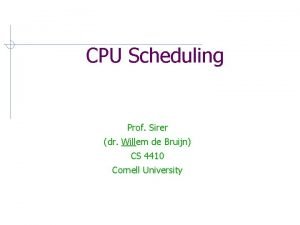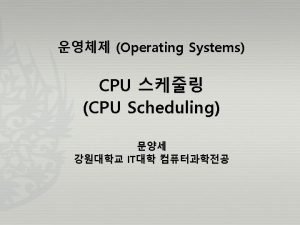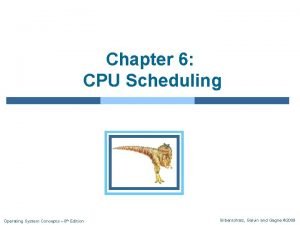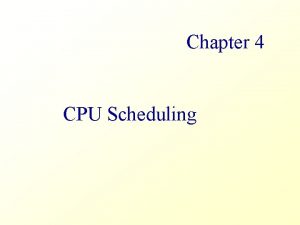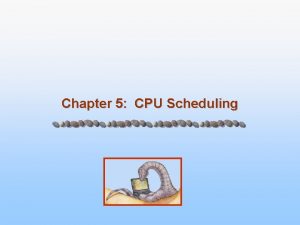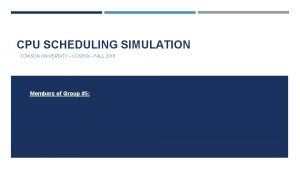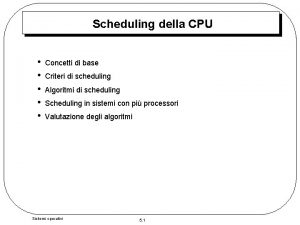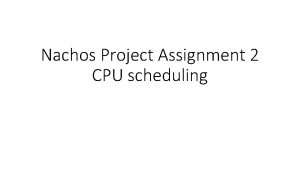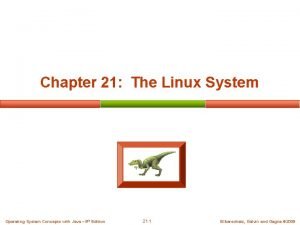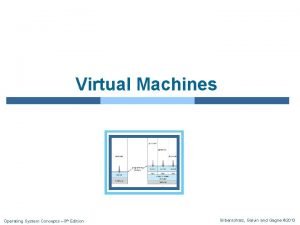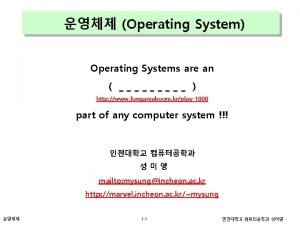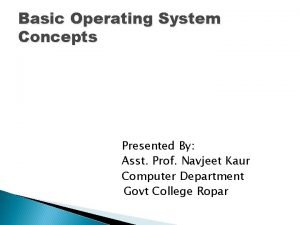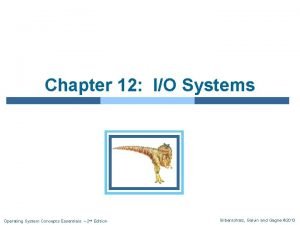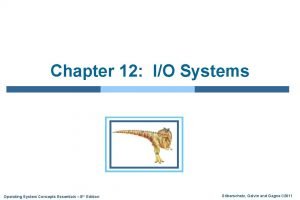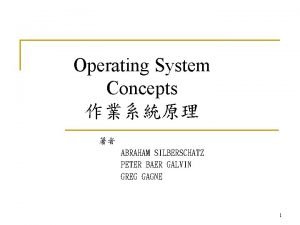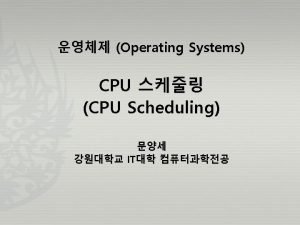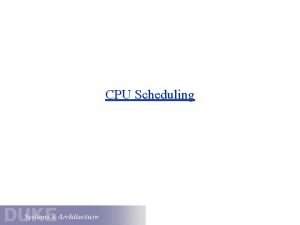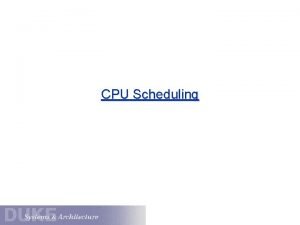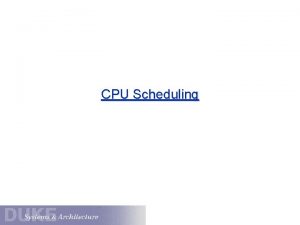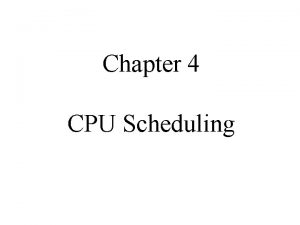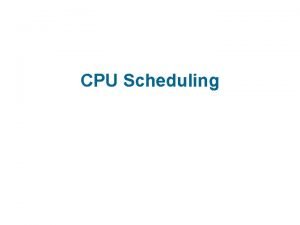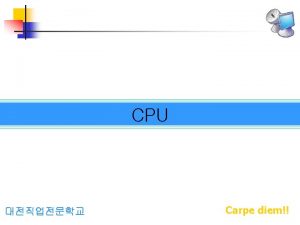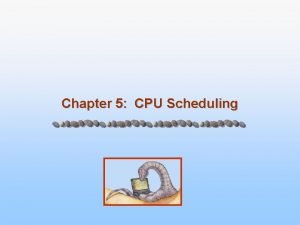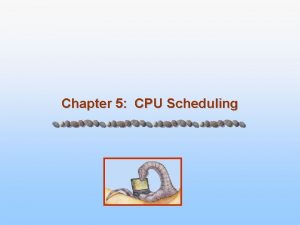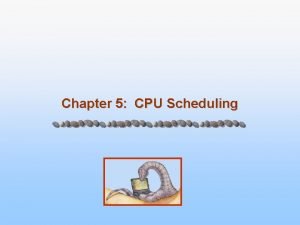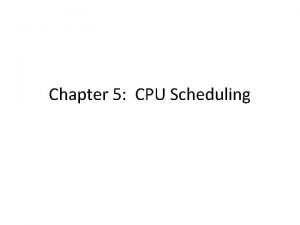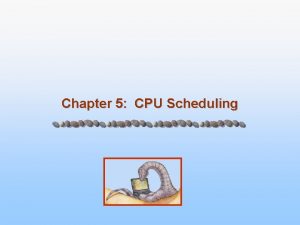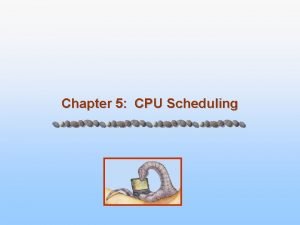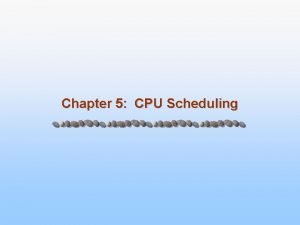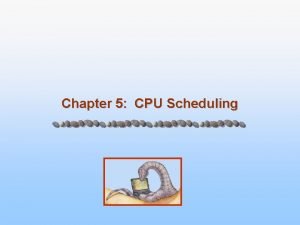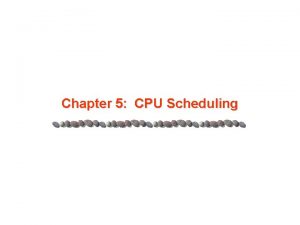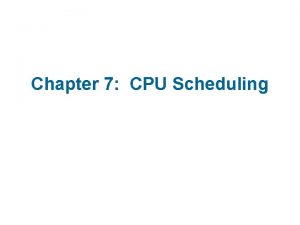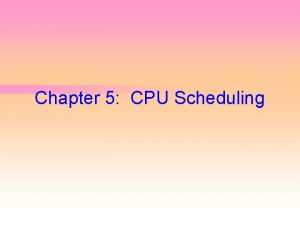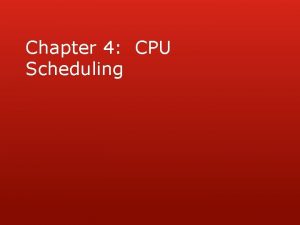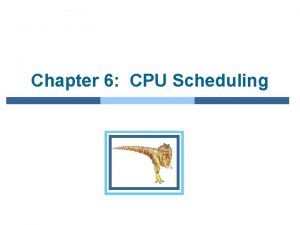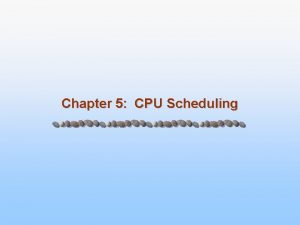Chapter 5 CPU Scheduling Operating System Concepts 10






























- Slides: 30

Chapter 5: CPU Scheduling Operating System Concepts – 10 th Edition Silberschatz, Galvin and Gagne © 2018

Chapter 5: CPU Scheduling n Basic Concepts n Scheduling Criteria n Scheduling Algorithms n Thread Scheduling n Multiple-Processor Scheduling n Real-Time CPU Scheduling n Operating Systems Examples n Algorithm Evaluation Operating System Concepts – 10 th Edition 5. 2 Silberschatz, Galvin and Gagne © 2018

Objectives n To introduce CPU scheduling, which is the basis for multiprogrammed operating systems n To describe various CPU-scheduling algorithms n To discuss evaluation criteria for selecting a CPU-scheduling algorithm for a particular system n To examine the scheduling algorithms of several operating systems Operating System Concepts – 10 th Edition 5. 3 Silberschatz, Galvin and Gagne © 2018

Shortest-Job-First (SJF) Scheduling n Associate with each process the length of its next CPU burst l n Use these lengths to schedule the process with the shortest time SJF is optimal – gives minimum average waiting time for a given set of processes l The difficulty is knowing the length of the next CPU request l Could ask the user If two processes have same length next CPU burst, FCFS scheduling is used to break the tie. n Two schemes: n l l nonpreemptive – once CPU given to the process it cannot be preempted until it completes its CPU burst. Preemptive – if a new process arrives with CPU burst length less than remaining time of current executing process, preempt. This scheme is know as the shortest-Remaining-Time-First (SRTF). Operating System Concepts – 10 th Edition 5. 4 Silberschatz, Galvin and Gagne © 2018

Example of Non-preemptive SJF Process. Arrival Time Burst Time P 1 0. 0 6 P 2 2. 0 8 P 3 4. 0 7 P 4 5. 0 3 n SJF scheduling chart n Average waiting time = (3 + 16 + 9 + 0) / 4 = 7 Operating System Concepts – 10 th Edition 5. 5 Silberschatz, Galvin and Gagne © 2018

Determining Length of Next CPU Burst n Long-term scheduling (batch system) n process time limit specified by the user l SJF scheduling is used frequently in long-term scheduling SJF cannot be implemented at the level of short-term CPU scheduling l n Can only estimate the length – should be similar to the previous one l n Then pick process with shortest predicted next CPU burst Can be done by using the length of previous CPU bursts, using exponential averaging 1. tn = actual length of nth CPU burst 2. n+1 = predicted value for the next CPU burst 3. , 0 1 3. Define: n+1 = tn + (1 - ) n n Commonly, α set to ½ n Preemptive version called shortest-remaining-time-first Operating System Concepts – 10 th Edition 5. 6 Silberschatz, Galvin and Gagne © 2018

Prediction of the Length of the Next CPU Burst Operating System Concepts – 10 th Edition 5. 7 Silberschatz, Galvin and Gagne © 2018

Examples of Exponential Averaging n =0 n+1 = n l Recent history does not count n =1 l n+1 = tn l Only the actual last CPU burst counts l n = 1/2 l recent and past history are equally weighted l 0 can be a constant or overall system average n If we expand the formula, we get: n+1 = tn+(1 - ) tn -1 + … +(1 - )j tn -j + … +(1 - )n +1 0 n Since both and (1 - ) are less than or equal to 1, each successive term has less weight than its predecessor Operating System Concepts – 10 th Edition 5. 8 Silberschatz, Galvin and Gagne © 2018

Example of Shortest-remaining-time-first n Now we add the concepts of varying arrival times and preemption to the analysis Process. Aarri Arrival Time. T Burst Time P 1 0 8 P 2 1 4 P 3 2 9 P 4 3 5 n Preemptive SJF Gantt Chart n Average waiting time = [(10 -1)+(17 -2)+5 -3)]/4 = 26/4 = 6. 5 msec Operating System Concepts – 10 th Edition 5. 9 Silberschatz, Galvin and Gagne © 2018

SRTF discussion n SRTF Pros & Cons l Optimal (average response time) (+) l Hard to predict future (-) l Unfair (-) Operating System Concepts – 10 th Edition 5. 10 Silberschatz, Galvin and Gagne © 2018

Priority Scheduling n A priority number (integer) is associated with each process n The CPU is allocated to the process with the highest priority (smallest integer highest priority) l Preemptive l Nonpreemptive n Equal-priority processes are scheduled in FCFS order n SJF is priority scheduling where priority is the inverse of predicted next CPU burst time n Problem Starvation – low priority processes may never execute n Solution Aging – as time progresses increase the priority of the process Operating System Concepts – 10 th Edition 5. 11 Silberschatz, Galvin and Gagne © 2018

Example of Priority Scheduling Process. A arri Burst Time. T Priority P 1 10 3 P 2 1 1 P 3 2 4 P 4 1 5 P 5 5 2 n Priority scheduling Gantt Chart n Average waiting time = 8. 2 msec Operating System Concepts – 10 th Edition 5. 12 Silberschatz, Galvin and Gagne © 2018

Round Robin (RR) n Each process gets a small unit of CPU time (time quantum q), usually 10100 milliseconds. After this time has elapsed, the process is preempted and added to the end of the ready queue. n RR scheduling is implemented as a FIFO queue of processes. n New processes are added to the tail of the ready queue. n A process may itself leave the CPU if its CPU burst is less than 1 quantum, otherwise timer will cause an interrupt and the process will be put at the tail of the queue Operating System Concepts – 10 th Edition 5. 13 Silberschatz, Galvin and Gagne © 2018

Example: RR with Time Quantum = 20 Process n Burst Time P 1 53 P 2 17 P 3 68 P 4 24 The Gantt chart is: P 1 0 P 2 20 37 P 3 P 4 57 P 1 77 P 3 P 4 P 3 97 117 121 134 154 162 n Waiting time for n Average waiting time = (81+20+94+97)/4=73 Operating System Concepts – 10 th Edition P 1=(77 -20)+(121 -97)= 81 P 2=(20 -0)=20 P 3=(37 -0)+(97 -57)+(134 -117)= 94 P 4=(57 -0)+(117 -77)= 97 5. 14 Silberschatz, Galvin and Gagne © 2018

Round Robin (RR) n Typically, higher average turnaround than SJF, but better response. n Round-Robin Pros and Cons: l Better for short jobs, Fair (+) l Context-switching time adds up for long jobs (-) Operating System Concepts – 10 th Edition 5. 15 Silberschatz, Galvin and Gagne © 2018

Round Robin (RR) n If there are n processes in the ready queue and the time quantum is q, then each process gets 1/n of the CPU time in chunks of at most q time units at once. l No process waits more than (n-1)q time units. n Example l 5 processes, time quantum = 20 4 each process will get up to 20 ms every 80 ms. n Performance l q large FCFS l q small processor sharing l 4 appears l l as though each of n processes has its own processor running at 1/n the speed of the real processor q must be large with respect to context switch, otherwise overhead is too high. q usually 10 ms to 100 ms, context switch < 10 sec Operating System Concepts – 10 th Edition 5. 16 Silberschatz, Galvin and Gagne © 2018

Time Quantum and Context Switch Time Operating System Concepts – 10 th Edition 5. 17 Silberschatz, Galvin and Gagne © 2018

Turnaround Time Varies With The Time Quantum 80% of CPU bursts should be shorter than q Operating System Concepts – 10 th Edition 5. 18 Silberschatz, Galvin and Gagne © 2018

Turnaround Time Varies With The Time Quantum n The average turnaround time can be improved if most processes finish their next CPU burst in a single time quantum. n Example l 3 processes, CPU burst = 10 for each 4 quantum = 1, average turnaround time = 29 4 quantum = 10, average turnaround time = 20 4 If context-switch time is added, average turnaround time will increase for smaller time quantum as there will be more number of context switches. n A rule of thumb l 80 percent of the CPU bursts should be shorter than the time quantum. Operating System Concepts – 10 th Edition 5. 19 Silberschatz, Galvin and Gagne © 2018

Multilevel Queue n Ready queue is partitioned into separate queues, eg: l foreground (interactive) l background (batch) n Process permanently in a given queue n Each queue has its own scheduling algorithm: n l foreground – RR l background – FCFS Scheduling must be done between the queues: l Fixed priority scheduling; (i. e. , serve all from foreground then from background). Possibility of starvation. l Time slice – each queue gets a certain amount of CPU time which it can schedule amongst its processes; i. e. , 80% to foreground in RR l 20% to background in FCFS Operating System Concepts – 10 th Edition 5. 20 Silberschatz, Galvin and Gagne © 2018

Multilevel Queue Scheduling Operating System Concepts – 10 th Edition 5. 21 Silberschatz, Galvin and Gagne © 2018

Multilevel Feedback Queue n A process can move between the various queues; aging can be implemented this way CPU-bound processes are moved to lower-priority queue. n I/O-bound and interactive processes get the higher-priority queue. n A process that waits too long in a lower-priority queue is moved to a higherpriority queue. n n Multilevel-feedback-queue scheduler defined by the following parameters: l number of queues l scheduling algorithms for each queue l method used to determine when to upgrade a process l method used to determine when to demote a process l method used to determine which queue a process will enter when that process needs service Operating System Concepts – 10 th Edition 5. 22 Silberschatz, Galvin and Gagne © 2018

Example of Multilevel Feedback Queue n n Three queues: l Q 0 – RR with time quantum 8 milliseconds l Q 1 – RR time quantum 16 milliseconds l Q 2 – FCFS Scheduling l l A new job enters queue Q 0 which is served FCFS 4 When it gains CPU, job receives 8 milliseconds 4 If it does not finish in 8 milliseconds, job is moved to queue Q 1 At Q 1 job is again served FCFS and receives 16 additional milliseconds 4 l If it still does not complete, it is preempted and moved to queue Q 2 Processes in Q 2 are run on an FCFS basis, only when Q 0 and Q 1 are empty Operating System Concepts – 10 th Edition 5. 23 Silberschatz, Galvin and Gagne © 2018

Fairness n Unfair in scheduling: STCF: *must* be unfair to be optimal l Favor I/O jobs? Penalize CPU. n How do we implement fairness? l Could give each queue a fraction of the CPU. 4 But this isn’t always fair. What if there’s one long-running job, and 100 short-running ones? l Could adjust priorities: increase priority of jobs, as they don’t get service. This is what’s done in UNIX. 4 Problem is that this is ad hoc – what rate should you increase priorities? 4 And, as system gets overloaded, no job gets CPU time, so everyone increases in priority. 4 The result is that interactive jobs suffer – both short and long jobs have high priority! l Operating System Concepts – 10 th Edition 5. 24 Silberschatz, Galvin and Gagne © 2018

Lottery scheduling: random simplicity n Give every job some number of lottery tickets n On each time slice, randomly pick a winning ticket. n On average, CPU time is proportional to # of tickets given to each job. n How do you assign tickets? l To approximate SRTF, short running jobs get more, long running jobs get fewer. l To avoid starvation, every job gets at least one ticket (so everyone makes progress). Operating System Concepts – 10 th Edition 5. 25 Silberschatz, Galvin and Gagne © 2018

Grace under load change n Adding or deleting a job (and their tickets): l n affects all jobs proportionately, independent of how many tickets each job has. For example, if short jobs get 10 tickets, and long jobs get 1 each, then: # short jobs / % of CPU each short % of CPU each long # long jobs job gets 1/1 91% 9% 0/2 NA 50% 2/0 50% NA 10/1 10% 1% 1/10 50% 5% Operating System Concepts – 10 th Edition 5. 26 Silberschatz, Galvin and Gagne © 2018

Thread Scheduling n Distinction between user-level and kernel-level threads n When threads supported, threads scheduled, not processes n Many-to-one and many-to-many models, thread library schedules user-level threads to run on LWP n l Known as process-contention scope (PCS) since scheduling competition is within the process l Typically done via priority set by programmer and are not adjusted by the thread library l Preempt the thread currently running in favor of a higher-priority thread l no guarantee of time slicing among threads of equal priority Kernel thread scheduled onto available CPU is system-contention scope (SCS) – competition among all threads in system l One-to-one model, such as Windows and Linux schedule threads using only SCS Operating System Concepts – 10 th Edition 5. 27 Silberschatz, Galvin and Gagne © 2018

Pthread Scheduling n n API allows specifying either PCS or SCS during thread creation l PTHREAD_SCOPE_PROCESS schedules threads using PCS scheduling l PTHREAD_SCOPE_SYSTEM schedules threads using SCS scheduling In the many-to-many model, the PTHREAD_SCOPE_PROCESS policy schedules user-level threads onto available LWPs l The number of LWPs is maintained by the thread library n The PTHREAD_SCOPE_SYSTEM scheduling policy will create and bind an LWP for each user-level thread n The Pthread IPC (Interprocess Communication) provides two functions for setting and getting the contention scope policy: n l pthread_attr_setscope(pthread_attr_t *attr, int scope) l pthread_attr_getscope(pthread_attr_t *attr, int *scope) Can be limited by OS – Linux and Mac OS X only allow PTHREAD_SCOPE_SYSTEM Operating System Concepts – 10 th Edition 5. 28 Silberschatz, Galvin and Gagne © 2018

Pthread Scheduling API #include <pthread. h> #include <stdio. h> #define NUM_THREADS 5 int main(int argc, char *argv[]) { int i, scope; pthread_t tid[NUM THREADS]; pthread_attr_t attr; /* get the default attributes */ pthread_attr_init(&attr); /* first inquire on the current scope */ if (pthread_attr_getscope(&attr, &scope) != 0) fprintf(stderr, "Unable to get scheduling scopen"); else { if (scope == PTHREAD_SCOPE_PROCESS) printf("PTHREAD_SCOPE_PROCESS"); else if (scope == PTHREAD_SCOPE_SYSTEM) printf("PTHREAD_SCOPE_SYSTEM"); else fprintf(stderr, "Illegal scope value. n"); } Operating System Concepts – 10 th Edition 5. 29 Silberschatz, Galvin and Gagne © 2018

Pthread Scheduling API /* set the scheduling algorithm to PCS or SCS */ pthread_attr_setscope(&attr, PTHREAD_SCOPE_SYSTEM); /* create threads */ for (i = 0; i < NUM_THREADS; i++) pthread_create(&tid[i], &attr, runner, NULL); /* now join on each thread */ for (i = 0; i < NUM_THREADS; i++) pthread_join(tid[i], NULL); } /* Each thread will begin control in this function */ void *runner(void *param) { /* do some work. . . */ pthread_exit(0); } Operating System Concepts – 10 th Edition 5. 30 Silberschatz, Galvin and Gagne © 2018
 Operating system concepts chapter 8 solutions
Operating system concepts chapter 8 solutions Operating system concepts chapter 5 solutions
Operating system concepts chapter 5 solutions Operating system concepts chapter 5 solutions
Operating system concepts chapter 5 solutions Disk structure in os
Disk structure in os Bf scheduler
Bf scheduler Turnaround time in os
Turnaround time in os Priority scheduling
Priority scheduling Sjf cpu scheduling
Sjf cpu scheduling Gantt chart fcfs
Gantt chart fcfs Sjf cpu scheduling
Sjf cpu scheduling Sjf cpu scheduling
Sjf cpu scheduling Waiting time in cpu scheduling
Waiting time in cpu scheduling A cpu scheduling algorithm determines an order
A cpu scheduling algorithm determines an order Cpu scheduling project
Cpu scheduling project Scheduling della cpu
Scheduling della cpu Cpu scheduling project
Cpu scheduling project Job scheduling vs process scheduling
Job scheduling vs process scheduling Operating system
Operating system Linux operating system concepts
Linux operating system concepts Operating system concepts with java
Operating system concepts with java Operating system concepts 6th edition
Operating system concepts 6th edition Operating system concepts 9
Operating system concepts 9 Realtime operating system
Realtime operating system 교보 drm
교보 drm Basic operating system concepts
Basic operating system concepts Operating system concepts 11th
Operating system concepts 11th Operating system concepts essentials
Operating system concepts essentials Operating system concepts essentials
Operating system concepts essentials Abraham silberschatz
Abraham silberschatz Operating systems
Operating systems Buddy system example
Buddy system example



